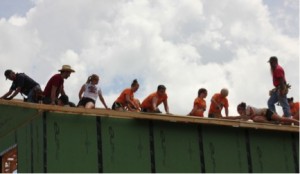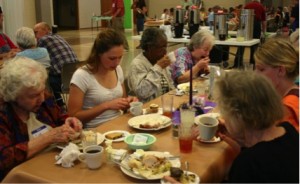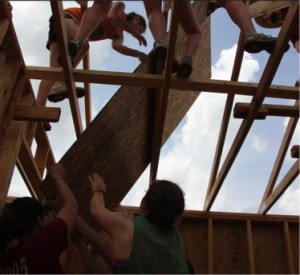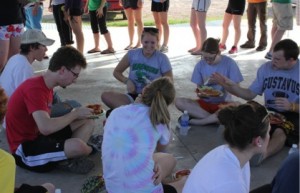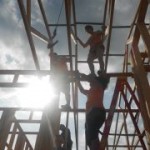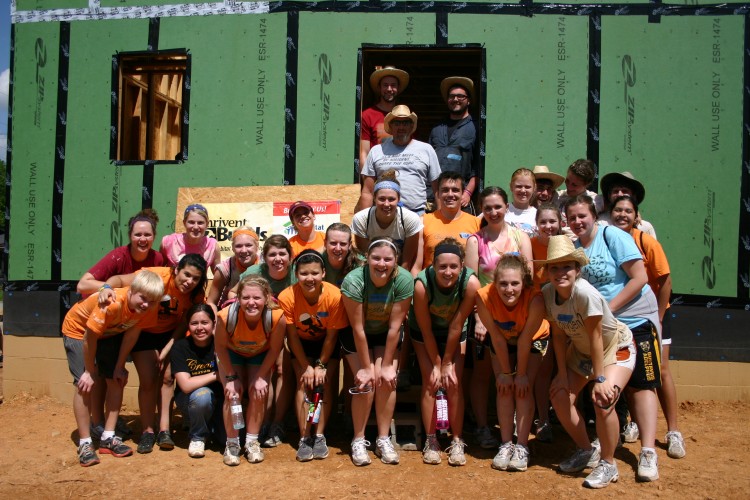
Gustavus students in Maryville, TN, 2012
Habitat for Humanity Alternative Spring Break: From House to Home
Dave Newell
“May this house serve not only as a shelter, but as a living space for love and community. Bless this house as it has been made with intention, love, care, gratitude and a servant’s heart. Protect the family from evil and harm. Bring strength to these very floors and walls, and allow them to serve as a strong foundation as the family embarks on a new journey with Christ’s guidance. Let the light that shines through these windows represent hope and the people who built this home in an effort to spread love. May this house be a gift of joy and an opportunity to demonstrate how much good there can be in the world. Bring peace, bring happiness, bring love. Amen.”
– Student prayer, written on the sub-floor of the house built in Maryville, TN.
The Habitat for Humanity Alternative Spring Break trips have provided fertile ground to explore servant leadership and to engage students in meaningful ways. Students have the opportunity to embrace the call for serving others and break away from the stereotypical version of spring break. For me, the Alternative Break program has provided the foundational experience that allows students to examine their own sense of purpose and place in the world. Each of us has heard the phrase, “home is where the heart is,” and this experience supplies an opportunity for students to search their hearts and redefine their own sense of community and “home.”
This past year, ninety-four Gustavus students traveled to three locations to build homes and experience community. Partnering with Habitat for Humanity, the students on this journey were charged with framing, roofing, painting walls, placing windows, and lots of hammering! More so, participants were asked to serve, not just through physical labor, but through listening to stories and fostering a sense of community within themselves and others.
Robert Greenleaf (1991) coined the term Servant Leadership, and in his seminal work “The Servant as Leader,” described the need for community: “All that is needed to rebuild community as a viable life form for large numbers of people is for enough servant-leaders to show the way, not by mass movements, but by each servant-leader demonstrating his own unlimited liability for a quite specific community-related group” (pg. 30). Using Greenleaf’s call for servant leaders to build community as the groundwork for the experience, the Habitat Alternative Spring Break trips are intentionally designed to encourage dialogue across socio-economic lines and cultural differences – aiming to increase and demonstrate the “unlimited liability” for the people we engage with. Students are immersed in community through two distinct occasions: working side-by-side with the future homeowners and sharing meals with members of the host community. These opportunities provide rich material for deep reflection on service and community for our students.
Working Side-By-Side
“Everyone deserves a safe and loving home. Some amazing people have had huge misfortune and ended up in really hard circumstances. I learned that Mrs. Betty and I are not that different… we both dream the same dreams.”
– Student serving in Maryville, TN
One of the most influential interactions students encounter is working side-by-side with the new homeowners. A significant requirement to be accepted for a house is for the approved family to provide “sweat equity,” which entails hundreds of hours on site working with the volunteers that are serving to build the home. By building together, volunteers and future homeowners are sharing the labor, sharing stories, and learning from one another. Upon meeting the family members, students are often struck by the stories and recognition that so few differences separate one from the other. A student from the Pensacola, FL trip stated, “I didn’t realize how much I had in common with the homeowners. I thought their life would be so different than mine, but found out that we face a lot of the same issues, just on a different scale.” The shared experience and connection to the homeowners offers a context for the house, putting faces and names to the walls they are working hard to construct.
Community Conversations
“One of the greatest services we can provide is simply listening to the stories, to the hardships and triumphs, to the loss and gain.”
– Student serving in Laredo, TX
Each group is expected to participate in at least one community meal where students from Gustavus are sitting across the table from local people. The dinners pair students with individuals who face the daily struggle for shelter and food and expose students to the need in the community. These meals take place in a church or a community center as a potluck or community meal provided for low-income individuals. Students often recognize that one of the greatest needs for individuals in poverty is simply to be heard – recognizing that the act of listening, hearing another’s story, and demonstrating a level of care just by taking time with someone, is truly a service in itself. One student wrote, “I talked with a lady at the community dinner who told me she had lived out of her car for the last 6 months and was just so thankful to have a place to stay and food to eat. It seemed like the best thing I could do was just hear her story and show her that I cared.”
Reflection
“I learned so much about myself and what I want to do with my life. Because of this trip I decided to switch majors – and change my life path”
– Student serving in Maryville, TN
Each of the immersion experiences is augmented by our commitment to reflection – examining the impact we have on the communities we serve and connecting student’s experiences to the big picture. As our colleague Chris Johnson (2006) declared, “By providing space, time, tools, and encouragement for students simply to pause and think, reflection opens up the possibility that they can become more aware of their fundamental connectedness with other people, their belonging to a common humanity, their shared place in realities larger than themselves” (p. 210). We intentionally provide time and space each day for students to engage in conversation to unpack their learning and perceptions from the day. In doing so, students examine what it means to be a part of a community, how their involvement has impacted those they are serving and the community they are working in, and what they have learned about themselves in the process. The conversations allow students the space to examine their experience in context and draw connections between their own perceptions and beliefs and those of the people they are serving.
Building Community, Building a Home
“To be ‘at home’ means many things. But for most, a positive sense of being at home arises from experiences of interbeing that enable us to know we are connected in trustworthy ways and have some confidence that we can make a difference.”
– Parks Daloz, Keen, Keen, & Daloz Parks, 1996, pg. 26
I have had the privilege of leading the Habitat Spring Break Trips for six years. Over that time, I have witnessed many wonderful things and have come to know the importance of meaningful engagement with someone different than ourselves. The most applicable example I can provide is in the changing of focus as we approach the trip, while we are on the trip, and after we return. Before we leave, students talk about place – where they are going and what activities they get to do – We get to go to the beach! On the trip, students talk about the work on the site and what they are seeing and doing – we just kayaked the Rio Grande! I learned how to use a hammer! I know what a 2×4 is! When we return, the paradigm has shifted, and students begin to share stories about people – they feel as though they are connected to something greater than themselves.
Ultimately, these relationships are what teach students about themselves – challenging beliefs and values and fostering empathy. I believe it is why we have so many students that come back year after year to participate in the trip. As Wheatley (1999) so eloquently wrote, “Relationships change us, reveal us, and evoke more from us. We do not live in a world that encourages separateness. Only when we join with others do our gifts become visible, even to ourselves” (pg. 67). We may frame walls, paint doors, and hammer nails, but the true power is that by sharing in the life of another we create a home – a community where our heart is. As one student put it, “The people we met in Maryville made us feel like one of them, and now when I think of Tennessee, I feel like I have a family there.”
References
Greenleaf, R.K. (1991). The servant as leader. Indianapolis, IN: The Robert K. Greenleaf Center.
Johnson, C. (2006). Deep learning and the big questions: Reflection in service-learning. In Johnson, B. T., & O’Grady, C. R. (Eds.) The spirit of service: Exploring faith, service, and social justice in higher education (pp. 209-230). Bolton, MA: Anker Publishing Company, Inc.
Parks Daloz, L. A., Keen, C. H., Keen, J. P., & Daloz Parks, S. (1996). Common fire: Leading lives of commitment in a complex world. Boston: Beacon Press.
Wheatley, M. J., & Kellner-Rogers, M. (1999). A simpler way. San Francisco: Berret-Koehler Publishers, Inc.
About the Author
DAVE NEWELL is a 2003 graduate from Gustavus and has worked as the Assistant Director for Community-Based Service and Learning for the past six years. Dave is focused on involving students in service and leadership opportunities, with his primary responsibilities of co-facilitating the Servant Leadership Program and advising the ongoing service programs offered through the Center for Servant Leadership. Dave has led the Habitat Alternative Spring Break trips each of his six years. He lives in Saint Peter with his wife and two daughters.
